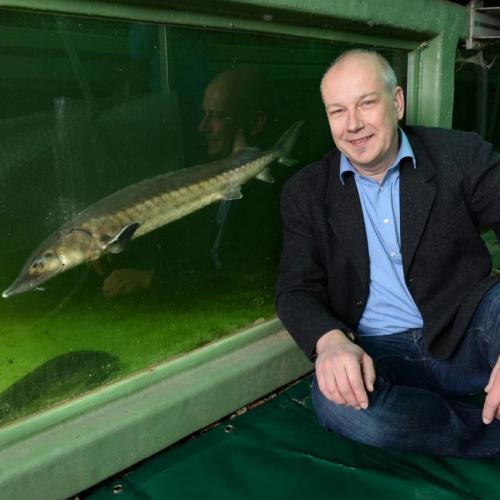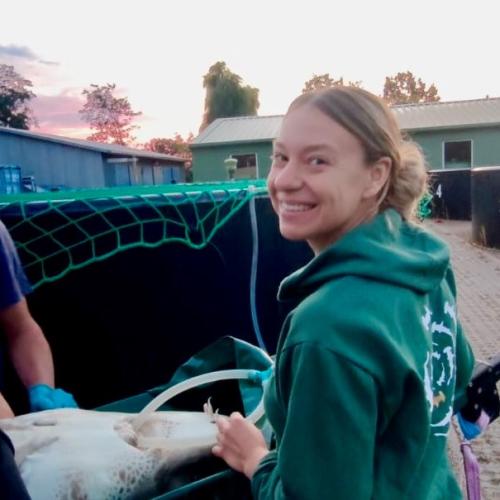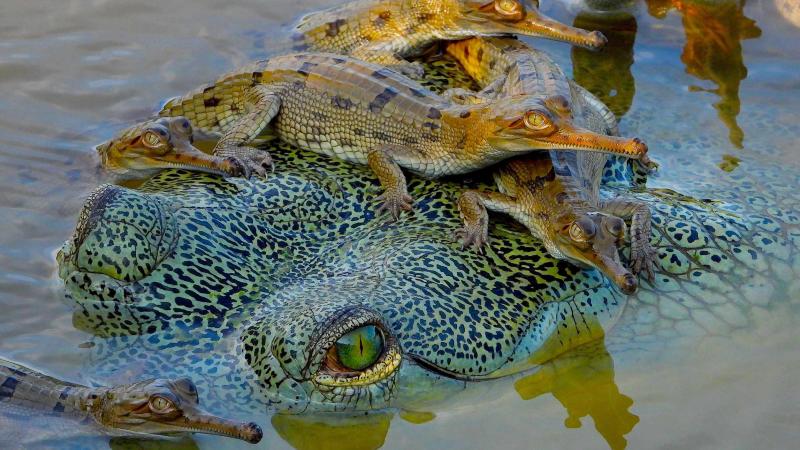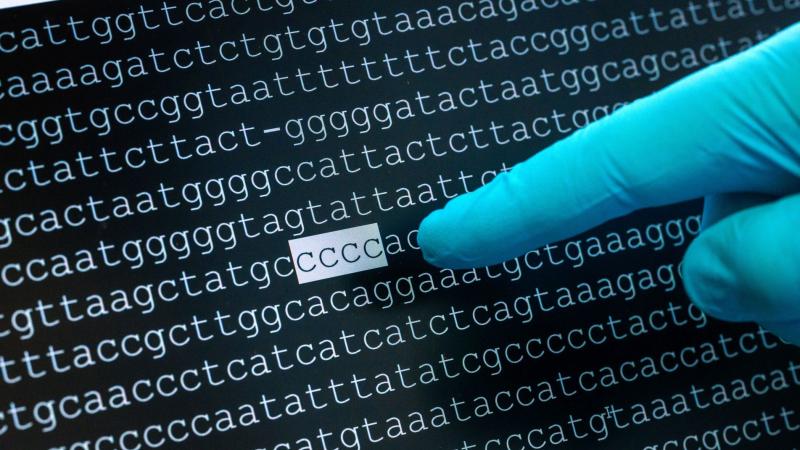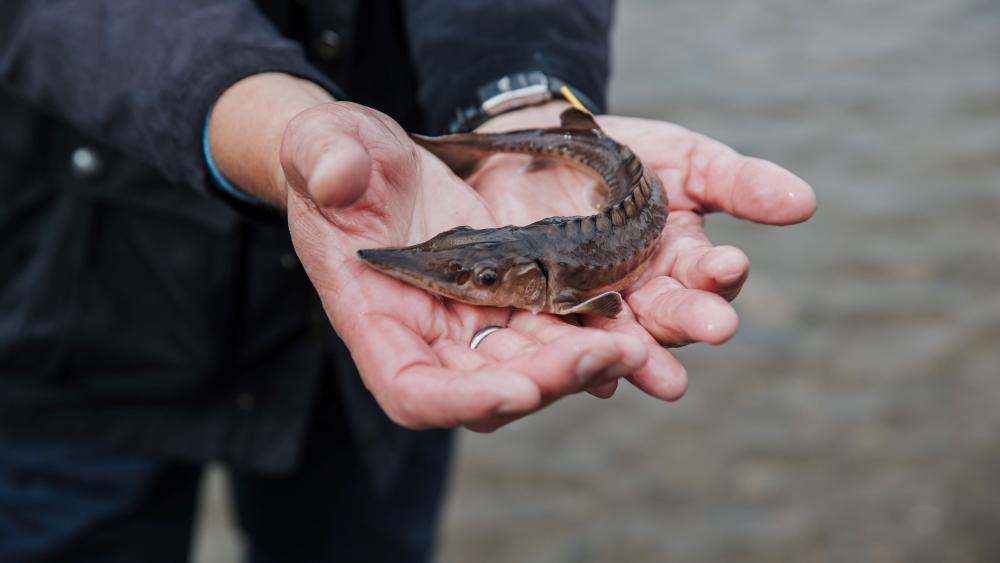
A young European sturgeon shortly before being released into the Elbe River. | © Sascha Hilgers/BMUV
The European sturgeon (Acipenser sturio) is an impressive migratory fish. It spawns in the lower and middle reaches of major Western European rivers, spends most of its life in the North Sea, and only returns to its home river to reproduce. These migrations make it particularly vulnerable to changes in rivers and coastal waters. The original population in the Elbe River has completely disappeared; the last animal was caught in 1985, and no natural reproduction has been recorded in Germany since 1964. Consequently, the European sturgeon is now listed as extinct on the Red List.ince 1964. The Red List therefore now lists the European sturgeon as extinct.
French offspring for the Elbe
To bring back the sturgeon, the IGB is working closely with the French research institute INRAe, using the offspring of the last remaining population in France as the basis for the reintroduction programme. A total of 20,000 of these animals have been released into the Elbe River since 2008.
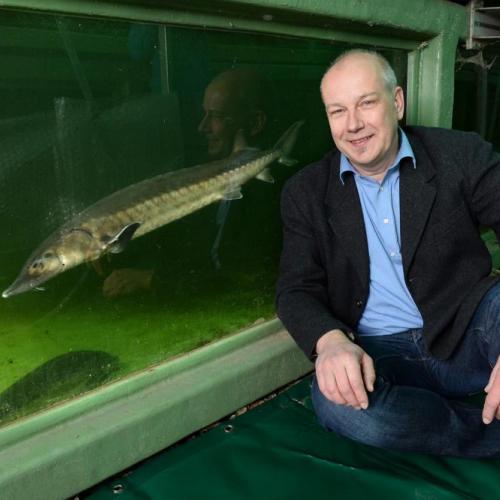
© David Ausserhofer/IGB
“If this umbrella species succeeds in re-establishing itself in the Elbe, many other species will also benefit, as will humans who live on and from the Elbe.”
Dr Jörn Geßner
Building up a spawning population like this requires patience, whether in captivity or in the wild. The fish only reach sexual maturity at around 15 years of age. This is how old the restocked sturgeons are when they return to the Elbe River for the first time. But is this sufficient time to significantly improve living conditions in the river? "Unfortunately, that is uncertain", said IGB researcher Dr Jörn Geßner, who has coordinated the reintroduction programme for three decades. "Despite our intensive efforts, we are facing major challenges." This is also evident from the 21 returnees that have been recorded in the Elbe River since 2020. More than two-thirds of these animals were found dead and therefore died before they could reproduce.
The greatest threats to the return of the sturgeon are:
- Water quality: The depletion of oxygen as a result of expansion and high nutrient loads, particularly in summer below the Port of Hamburg, leads to the suffocation of migrating animals.
- Hydromorphology: Changes to the river structure and a lack of passability make migration difficult or impossible. The Elbe still provides suitable habitats in certain areas. However, tributaries such as the Saale and the Havel are no longer accessible to sturgeon; many of their former habitats were destroyed during the development of the river for shipping and agricultural purposes.
- Tributaries such as the Saale and Havel rivers are no longer accessible to sturgeons, as many of their former habitats were destroyed when the rivers were developed for shipping.
- Shipping and fishing: Injuries caused by shipping (e g. propeller strikes) and suction dredgers, as well as unintended bycatch in fishing, directly impact the mortality of these animals.
- Climate change: Shifting precipitation patterns, extreme weather and rising temperatures are decoupling reproductive cycles from seasonal signals. Consequently, the Mediterranean region, which used to be part of the sturgeon's range, is now too warm and too dry for the sturgeon.
A symbol of a healthy Elbe River?
The reintroduction programme and the International Commission for the Protection of the Elbe (IKSE) therefore both aim to enhance the river's ecological value, restore habitats, and improve navigation on the Elbe.
“The stocking is a symbol of the opportunities that arise from a healthy Elbe. If this umbrella species succeeds in re-establishing itself in the Elbe, many other species will also benefit, as will humans who live on and from the Elbe”, emphasised Jörn Geßner.
Regular stocking campaigns are therefore important steps towards the return of the sturgeon, as are efforts to improve the health of the river. In the long term, it should once again become an integral part of the Elbe system's species inventory – serving as a symbol of the sustainable restoration of the river landscape, which extends beyond the protection of a single species and beyond national borders.
The European sturgeon at a glance
- Scientific name: Acipenser sturio
- Status: critically endangered (IUCN)
- Habitat: North Sea and spawning rivers such as the Elbe
- Way of life: migratory fish; spends most of its life in the sea but returns to its home river to spawn
- Size: up to 5 metres long, weight up to 200 kg
- Age at sexual maturity: around 15 years
- History in the Elbe: the last animal of the original population was caught in 1985; no natural reproduction has been detected since 1964
- Reintroduction programme: gradual stocking of offspring from a French population since 2008; goal: establishment of a self-sustaining population


